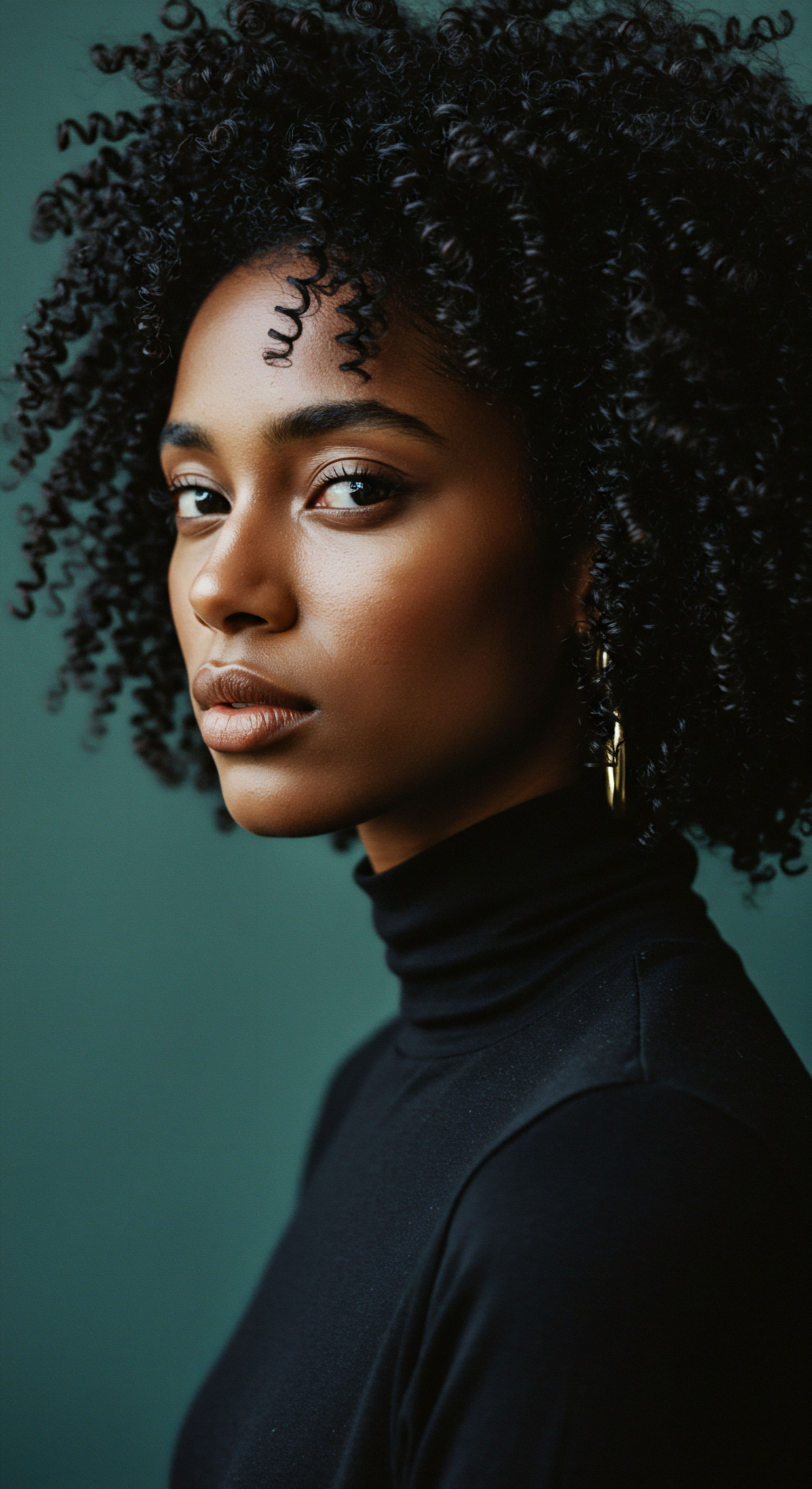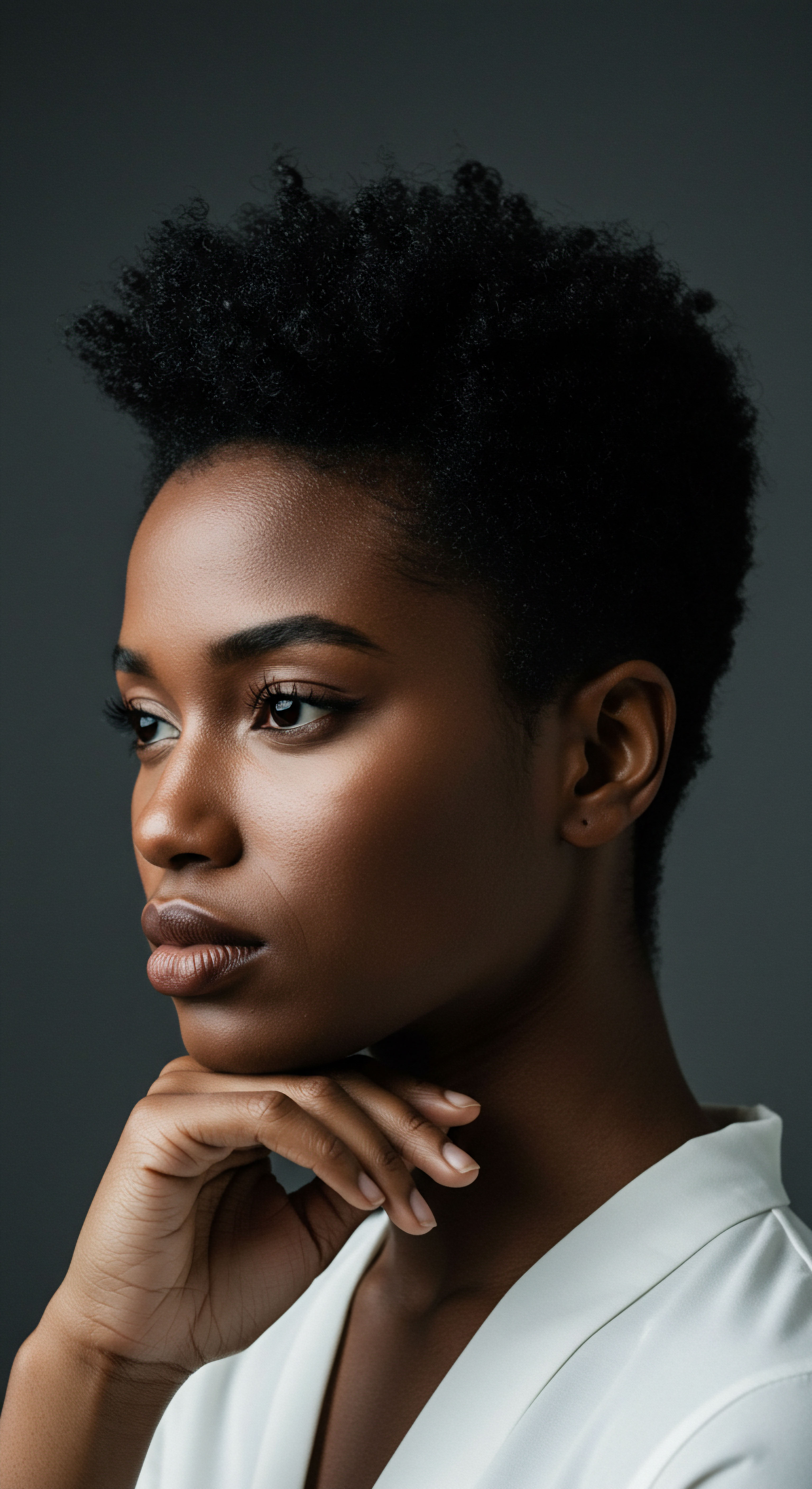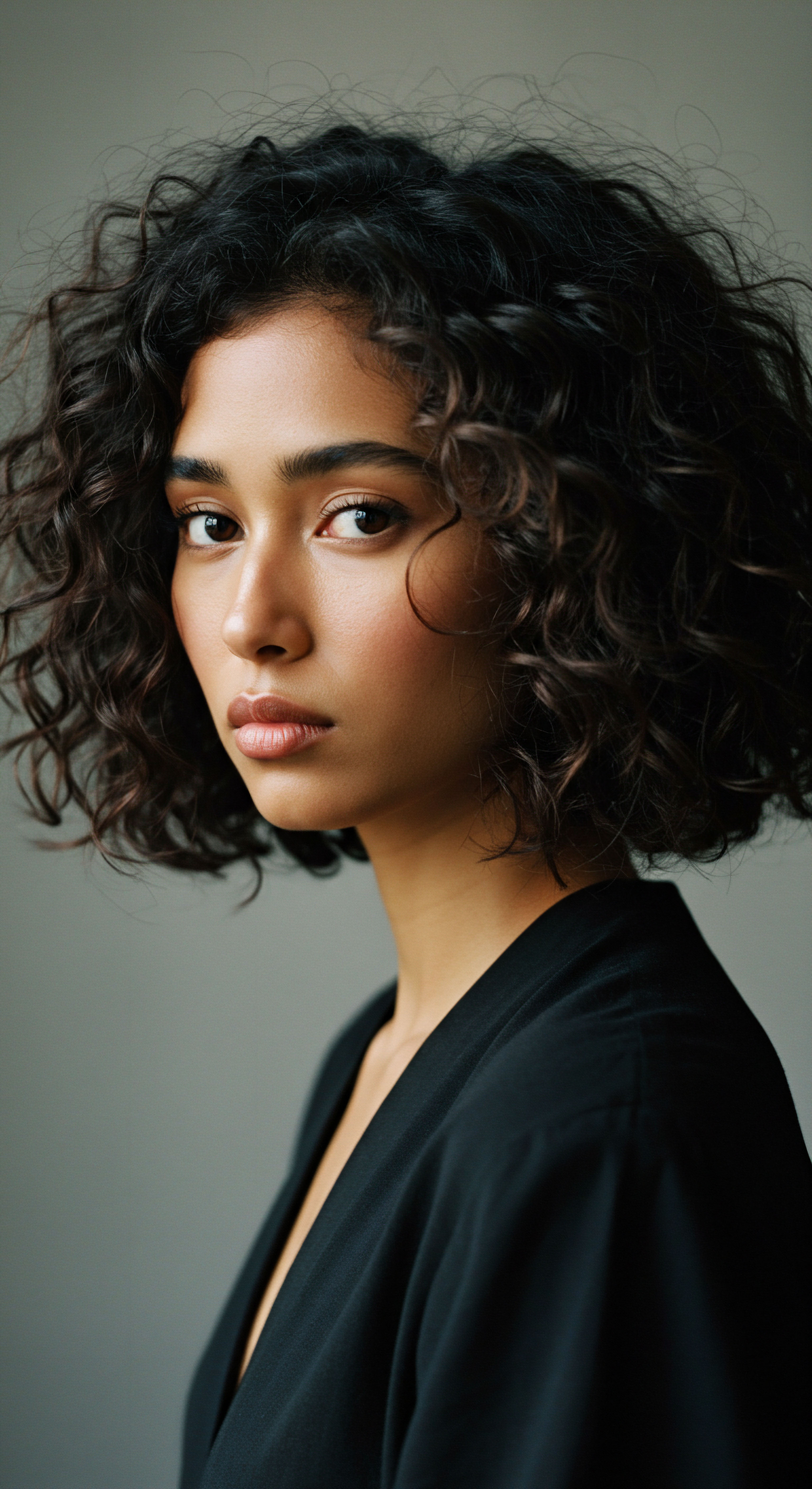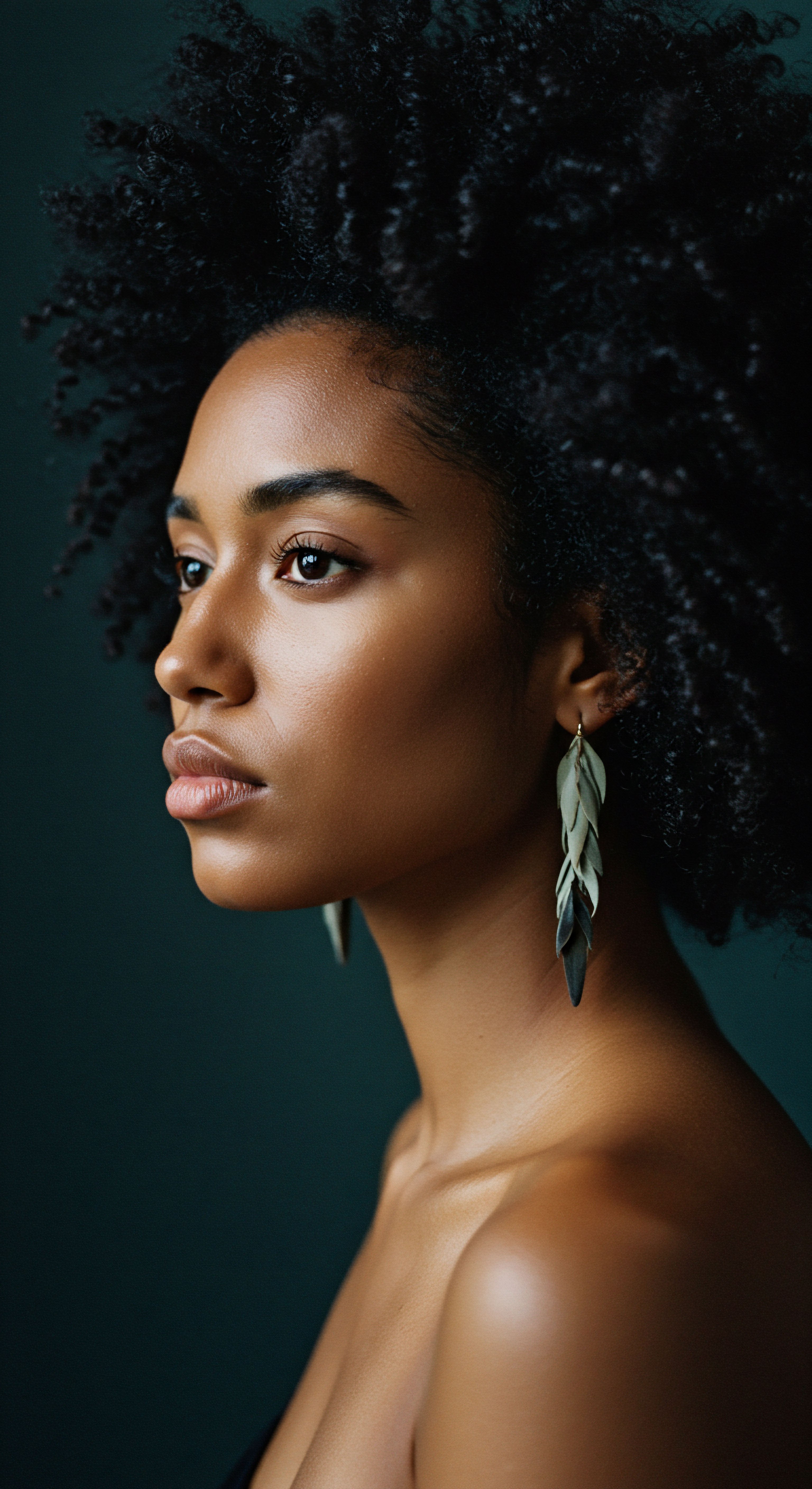
Roots
Consider, for a moment, the quiet conversations held within the coils and curls of textured hair, extending back through generations. These strands, often seen simply as a matter of personal style or daily routine, have long borne witness to the profound interplay of human circumstance and economic standing. From ancient marketplaces to modern boardrooms, the relationship between one’s hair and their material condition has been a subtle yet potent force, shaping not only appearance but also access, opportunity, and self-perception. This connection, far from being a mere footnote in social history, runs deep, revealing how economic realities have consistently molded hair practices, and how, in turn, hair has often reflected, and sometimes even defied, economic constraints.

Pre-Colonial Hair as a Social Indicator
Long before the shadows of transatlantic trade touched African shores, hair served as a sophisticated visual language across diverse communities. It was a living record, conveying a person’s age, marital status, religious affiliation, and even their position within society. In many West African societies, the intricate patterns of cornrows or the height of a styled coiffure could speak volumes about one’s wealth or social standing. A person with an elaborate, well-maintained hairstyle often signaled access to time and resources, perhaps indicating a life not burdened by constant manual labor, or the means to employ skilled stylists.
This was not simply about aesthetics; it was a form of communication, a public declaration of identity and status. For instance, in some cultures, the thickness and length of a woman’s braids could signify her ability to produce bountiful harvests or bear healthy children, connecting physical appearance directly to economic productivity and communal prosperity.
Hair, in its varied forms, has long served as a visual testament to one’s place within societal structures, reflecting economic realities and communal standing.
The communal act of hair styling itself carried economic and social weight. It was a practice often spanning hours, a shared ritual where stories were exchanged, wisdom passed down, and social bonds strengthened. The tools used, from specialized combs to natural oils and adornments like cowrie shells or beads, also held value, representing local resources and trade networks. These practices were deeply integrated into the economic fabric of daily life, where hair care was an investment in social capital and personal identity.

The Economic Stripping of Identity During Enslavement
The transatlantic slave trade brutally severed these connections, initiating a profound shift in hair practices for millions of Africans. One of the first acts of dehumanization by slave traders was often the shaving of heads upon capture, a deliberate attempt to strip individuals of their cultural identity and sever ties to their heritage. This act was not merely for “sanitary reasons,” as often claimed, but a psychological weapon, reducing diverse individuals to anonymous goods.
Once enslaved, the economic realities of forced labor dictated hair care. Access to traditional tools, nourishing oils, and the time required for elaborate styling vanished. Hair, once a source of pride and communication, became matted, tangled, and often hidden under headwraps. These wraps, while offering practical protection from harsh labor conditions, also became a symbol of oppression and a means to make enslaved women less attractive to their captors.
A stark hierarchy emerged within the enslaved community, directly tied to hair texture and skin tone. Those with lighter skin and straighter hair, often the result of forced relations, were sometimes afforded comparatively less brutal conditions, such as working in the plantation house. This distinction, while still horrific, offered a semblance of economic advantage, reinforcing the notion that proximity to Eurocentric features could lead to marginal “privileges” within the oppressive system. This insidious preference for straighter hair, termed “texturism,” began to take root, creating divisions and perpetuating a beauty standard that would persist for generations.
| Era Pre-Colonial Africa |
| Hair Practice Elaborate braids, coiffures, adornments |
| Economic Connection Signified wealth, social standing, time for self-care, access to resources. Hairdressers held skilled positions. |
| Era Slavery (Initial Stages) |
| Hair Practice Forced shaving, hidden under wraps |
| Economic Connection Dehumanization, loss of cultural identity, lack of time/resources for care. |
| Era Slavery (Ongoing) |
| Hair Practice Simpler styles, use of makeshift products |
| Economic Connection Limited resources, labor demands, hair as a marker of perceived "value" within the oppressive system. |

Post-Emancipation Adaptations and Economic Pressures
Following emancipation, African Americans faced new economic struggles within a society still deeply entrenched in racial discrimination. The pursuit of economic stability often meant conforming to prevailing white societal norms, which extended to appearance. Straight hair became a symbol of respectability and a perceived gateway to employment and social acceptance. This created a market for hair straightening products and tools.
The invention and popularization of the hot comb by figures like Madam C.J. Walker offered a means to achieve straightened styles, allowing Black women to navigate a society where straight hair was often seen as “orderly” and “professional.” Walker herself became one of the first African American millionaires through her hair care empire, demonstrating the significant economic demand for products that promised not just beauty, but also social and economic advancement. However, this economic opportunity came with a complex legacy, perpetuating the idea that straight hair was a prerequisite for upward mobility. The choice of hairstyle became a tangible economic decision, with natural textures often viewed as a barrier to professional success.

Ritual
Stepping from the foundational past, we arrive at the realm of daily practice, where the rhythms of hair care intertwine with the currents of economic life. The ways we attend to our hair, the products we select, and the services we seek are not merely personal preferences; they are often deeply influenced by our economic standing and the broader economic landscape. Consider the delicate balance between aspiration and affordability, the quiet calculations made when choosing between a desired product and a household necessity. These rituals, whether simple or elaborate, reflect a continuous dialogue between personal expression and the very real constraints of the purse.

The Rise of the Black Beauty Industry and Economic Independence
The late 19th and early 20th centuries witnessed the birth of a vibrant Black beauty industry, born out of necessity and driven by entrepreneurship in the face of racial segregation. White-owned cosmetic firms largely ignored the specific needs of Black consumers, and white hairdressers often refused service to women of color. This void presented an economic opportunity for Black women, who, despite societal barriers, established their own businesses.
Beauty parlors became more than just places for hair styling; they transformed into vital community hubs, centers of economic activity, and even clandestine sites for social and political organizing. Black beauticians, often economically autonomous and not reliant on white clientele, used their shops as safe spaces where women could gather, share information, and discuss issues freely. Professor Tiffany Gill’s work highlights how these salons hosted voter registration drives and provided citizenship education, demonstrating their profound impact beyond hair.
- Madam C.J. Walker ❉ Her enterprise not only offered products but also created economic avenues for thousands of Black women who became agents, selling her wares door-to-door.
- Economic Autonomy ❉ Owning a beauty salon provided a pathway to financial independence for Black women, a significant achievement in an era of limited opportunities.
- Community Building ❉ These spaces facilitated collective action and shared support, demonstrating how economic ventures could serve broader social and political goals.

Product Accessibility and the Cost of Conformance
As the 20th century progressed, the accessibility of various hair products—from chemical relaxers to hot combs—became intertwined with economic status. While home-based straightening methods offered a more affordable alternative to salon services, the products themselves still represented a recurring cost. The societal pressure to conform to Eurocentric beauty standards, which often equated straight hair with professionalism and social acceptance, meant that many Black women felt compelled to invest in these methods, regardless of the financial strain.
This created a cycle where economic advancement was often perceived as contingent upon altering one’s natural hair texture. The desire for employment or social mobility often meant accepting the financial burden of chemical treatments or frequent heat styling, which could also lead to hair damage, requiring further investment in restorative products.
Hair care rituals, far from being superficial, often embody a delicate balance between personal expression and the economic pressures of societal conformity.

The Natural Hair Movement and Shifting Economic Landscapes
The resurgence of the natural hair movement, particularly gaining momentum in the early 2000s, marked a significant cultural and economic shift. For many, embracing natural texture was a statement of self-acceptance and cultural pride, a conscious rejection of Eurocentric beauty ideals. This movement brought about new economic considerations.
Initially, some perceived going “natural” as a cost-saving measure, avoiding expensive relaxers and salon visits. However, this often gave way to the realization that natural hair care also required a distinct approach, often involving a new array of specialized products and tools. The market responded with a boom in natural hair care products, leading to a new segment within the beauty industry.
While this created opportunities for Black-owned businesses to cater to this specific market, it also introduced new economic complexities. Studies have shown that products formulated for textured hair can be significantly more expensive per unit than those for straight hair, a phenomenon sometimes referred to as a “texture tax.” This pricing disparity means that even within the natural hair movement, economic status continues to shape accessibility and choice, requiring careful budgeting and product selection.

Relay
Now, we arrive at a vantage point offering a broader view, where the subtle currents of individual practice converge with the sweeping tides of societal economics and cultural expectations. How do deeply ingrained societal norms, often invisible in their daily operation, translate into tangible economic burdens or opportunities related to hair? This section seeks to unravel the complex interplay between appearance, perception, and financial standing, revealing how historical biases continue to echo in contemporary economic realities, sometimes in surprising and challenging ways. We examine the structural forces that shape our choices, demonstrating that hair is seldom merely a personal aesthetic; it is a point of economic negotiation.

The Economic Weight of Hair Discrimination
In many professional and educational settings, a pervasive, often unspoken, standard of “professionalism” continues to align with Eurocentric hair textures. This societal expectation places a significant economic burden on individuals with textured hair, particularly Black women, who may feel compelled to alter their natural hair to conform. This pressure can manifest in substantial financial costs, as straightening processes, such as chemical relaxers or frequent heat styling, require regular investment. Permanent straightening, for instance, can cost between $38 and $435 per session, representing a considerable recurring expense.
Beyond direct costs, the economic implications extend to employment opportunities and career progression. Research consistently shows that hair discrimination remains a systemic barrier. A 2020 study conducted at Duke University’s Fuqua School of Business found that Black women with natural hairstyles, including Afros, braids, or twists, were perceived as less professional, less competent, and less likely to be recommended for job interviews than Black women with straightened hair or white women with any hair type. This bias was particularly pronounced in industries with conservative dress norms, such as consulting.
The perception of professionalism, often rooted in Eurocentric hair standards, can impose a tangible economic cost on those with textured hair, affecting employment and career paths.
The impact of this discrimination is quantifiable. The 2023 CROWN Workplace Research Study, co-commissioned by Dove and LinkedIn, revealed that Black women’s hairstyles were 2.5 times more likely to be deemed unprofessional by those interviewed. This bias translates into missed opportunities ❉ a quarter of Black women believe they have been denied a job interview because of their hair.
Furthermore, 20% of Black women aged 25-34 have been sent home from their jobs due to their hair. Such disciplinary actions can lead to termination or hinder advancement to higher positions, exacerbating existing economic disparities.
| Impact Area Direct Financial Cost |
| Description Expenses for chemical treatments or frequent styling to conform to Eurocentric standards. |
| Supporting Data Permanent straightening ❉ $38-$435 per session. |
| Impact Area Employment Barriers |
| Description Reduced likelihood of job interviews or offers due to natural hair. |
| Supporting Data 25% of Black women believe they've been denied an interview due to hair. |
| Impact Area Workplace Sanctions |
| Description Being sent home, demoted, or fired for hair choices. |
| Supporting Data 20% of Black women 25-34 sent home from jobs due to hair. |
| Impact Area Perception of Professionalism |
| Description Natural hairstyles often viewed as less professional or competent. |
| Supporting Data Black women's hairstyles 2.5x more likely to be deemed unprofessional. |

The “Texture Tax” and Consumer Spending
Beyond the pressures of workplace conformity, another economic dimension emerges in the form of a “texture tax” on hair care products. Research indicates that products specifically formulated for textured, coily, or curly hair types are often significantly more expensive per ounce than those designed for straight hair. This pricing disparity means that Black consumers, who already spend a disproportionately large amount on hair and beauty products, face an additional financial burden.
For instance, Black women spend nine times more on ethnic hair products than non-Black consumers. Despite making up only 2% of the UK’s adult population, Black women account for 10% of the total hair care spending each year in the UK. This is not simply a matter of preference; textured hair often has distinct needs regarding moisture retention and breakage prevention, requiring specialized formulations that may be more costly to produce, or are priced higher due to market segmentation.
This economic reality forces many Black women to allocate a substantial portion of their budget to hair care. The average Black consumer in the United States spends an estimated $473 million annually on hair care products. This financial outlay, coupled with the “texture tax,” highlights how economic status dictates access to suitable products and, by extension, the ability to maintain hair health and desired styles without undue financial strain. The struggle to find affordable, effective products for textured hair remains a persistent concern for many.

Hair as a Catalyst for Economic Empowerment and Policy Change
Amidst these challenges, hair has also served as a powerful catalyst for economic empowerment and social change. The natural hair movement has spurred a thriving industry, with Black-owned businesses leading the way in developing products and services tailored to textured hair. This has created new entrepreneurial avenues and employment opportunities within the Black community, shifting consumer spending towards brands that understand and cater to their unique needs.
Furthermore, the fight against hair discrimination has gained legislative momentum with the CROWN Act (Creating a Respectful and Open World for Natural Hair). This legislation, passed in many U.S. states, prohibits discrimination based on hair texture or protective styles historically associated with race. The Act aims to remove economic barriers by ensuring that individuals are not denied jobs, promotions, or educational opportunities because of their natural hair.
While progress is ongoing, with federal legislation still facing hurdles, the CROWN Act represents a significant step towards economic equity, affirming the right to cultural expression without professional penalty. It underscores how legal and social changes can directly impact the economic lives of individuals, transforming hair from a potential liability into a celebrated aspect of identity.

Reflection
The story of hair and economic status is a deeply personal one, yet it is also a collective chronicle of resilience, adaptation, and profound social shifts. Our hair, in its infinite forms, continues to echo the whispers of history and the vibrant rhythms of the present, serving as a silent, yet eloquent, witness to the ongoing dance between personal identity and the broader economic landscape. It reminds us that beauty, commerce, and human dignity are often inextricably intertwined, inviting a deeper consideration of the choices we make and the world we wish to cultivate.

References
- Byrd, Ayana D. and Lori L. Tharps. Hair Story ❉ Untangling the Roots of Black Hair in America. St. Martin’s Press, 2001.
- Chang, C. J. et al. “Use of Hair Products in Relation to Uterine Leiomyoma in the Sister Study.” Environmental Health Perspectives, vol. 130, no. 5, 2022.
- Duke University’s Fuqua School of Business. “Research Suggests Bias Against Natural Hair Limits Job Opportunities for Black Women.” Duke Today, 12 Aug. 2020.
- Gill, Tiffany M. Beauty Shop Politics ❉ African American Women’s Activism in the Beauty Industry. University of Illinois Press, 2010.
- Koval, Christy Zhou, and Ashleigh Shelby Rosette. “The Natural Hair Bias in Job Recruitment.” Social Psychological and Personality Science, vol. 12, no. 5, 2021, pp. 689-699.
- NielsenIQ. Diverse Intelligence Series ❉ Black Consumers are Leading the Way in Beauty and Personal Care. 2023.
- Opie, T. L. and K. W. Phillips. “The Effects of Afrocentric Hairstyles on Perceptions of Professionalism in African American Women.” Journal of Black Psychology, vol. 41, no. 4, 2015, pp. 370-388.
- Sow, Yacine N. et al. “Minority Hair Tax ❉ Pricing Bias in Haircare Products.” International Journal of Women’s Dermatology, vol. 9, no. 4, 2023, pp. e064.
- Stiel, L. et al. “Hair Relaxer Use and Risk of Breast Cancer.” Carcinogenesis, vol. 36, no. 11, 2015, pp. 1312-1317.
- Tharps, Lori L. “What Every Dermatologist Must Know About the History of Black Hair.” Cutis, vol. 112, no. 5, 2023, pp. 263-266.